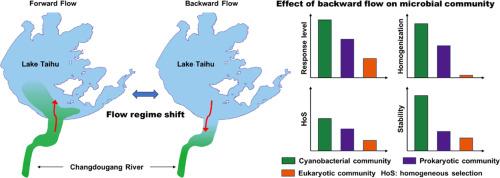连接太湖的河流中蓝藻、原核生物总量和真核生物对逆流的反应依次下降
IF 11.4
1区 环境科学与生态学
Q1 ENGINEERING, ENVIRONMENTAL
引用次数: 0
摘要
由于人类活动(如城市化和水文变化)导致水流机制发生变化,河流生态系统面临着日益严峻的挑战。人们对微生物群落在水流变化的生态系统中的作用的了解仍不全面,仍处于水生微生物生态学的前沿。特别是,河流倒流对水生生物群的影响在很大程度上仍然未知。因此,我们通过环境 DNA 代谢编码研究了逆流对自然流入太湖的长斗港河中蓝藻、原核生物和真核生物群落的影响。我们分析了后向、弱向和前向流向条件下群落多样性、集合度和生态网络稳定性的差异。非度量多维尺度显示,不同流向条件下群落的群落差异高于季节性群落。α和β多样性的变化表明,在逆流条件下,蓝藻群落和原核生物群落的同质性很强,而真核生物群落的生态独特性则有所下降。三种与水流有关的群落的形成主要受随机过程中的漂移和扩散限制的影响。然而,在蓝藻群落中,确定性过程中的同质性选择在逆流条件下从 22.79% 增加到 42.86%,这与棋盘格得分(C-score)中观察到的趋势一致。更重要的是,生态网络的拓扑特性和平均变异程度表明,蓝藻群落的稳定性高于原核生物和真核生物群落。考虑到内聚力的变化,蓝藻群落的网络稳定性在逆流条件下有所下降。我们的发现强调了蓝藻群落、原核生物群落和真核生物群落对逆流河流的不同反应和依次递减。这些知识对于维护河流生态健康、评估生态对水文工程的复杂影响以及制定可持续的水资源管理策略至关重要。本文章由计算机程序翻译,如有差异,请以英文原文为准。

Sequential decline in cyanobacterial, total prokaryotic, and eukaryotic responses to backward flow in a river connected to Lake Taihu
River ecosystems face escalating challenges due to altered flow regimes from human activities, such as urbanization with hydrological modifications. Understanding the role of microbial communities for ecosystems with changing flow regimes is still incomplete and remains at the frontier of aquatic microbial ecology. In particular, influences of riverine backward flow on the aquatic biota remain largely unknown. Therefore, we examined the impact of backward flow on the cyanobacterial, total prokaryotic, and eukaryotic communities in the Changdougang River, which naturally flows into Lake Taihu, through environmental DNA metabarcoding. We analyzed the differences in community diversity, assembly, and ecological network stability among groups under backward, weak, and forward flow direction conditions. Non-metric multidimensional scaling showed higher variations in communities of groups across flow direction conditions than seasonal groups. Variations in alpha and beta diversity showed that cyanobacterial and total prokaryotic communities experienced strong homogenization under backward flow conditions, whereas the ecological uniqueness of the eukaryotic community decreased. Assembly of the three flow-related communities was primarily governed by drift and dispersal limitation in stochastic processes. However, in the cyanobacterial community, homogeneous selection in deterministic processes increased from 22.79% to 42.86% under backward flow, aligning with trends observed in the checkerboard score (C-score). More importantly, the topological properties of ecological networks and the degree of average variation revealed higher stability in the cyanobacterial community compared to total prokaryotic and eukaryotic communities. Considering the variations in cohesion, the network stability in the cyanobacterial community decreased under backward flow. Our findings emphasize the distinct and sequentially diminishing responses of cyanobacterial, total prokaryotic, and eukaryotic communities to backward flowing rivers. This knowledge is crucial for maintaining ecological health of rivers, assessing the complex ecological impacts on hydrological engineering, and formulating sustainable water management strategies.
求助全文
通过发布文献求助,成功后即可免费获取论文全文。
去求助
来源期刊

Water Research
环境科学-工程:环境
CiteScore
20.80
自引率
9.40%
发文量
1307
审稿时长
38 days
期刊介绍:
Water Research, along with its open access companion journal Water Research X, serves as a platform for publishing original research papers covering various aspects of the science and technology related to the anthropogenic water cycle, water quality, and its management worldwide. The audience targeted by the journal comprises biologists, chemical engineers, chemists, civil engineers, environmental engineers, limnologists, and microbiologists. The scope of the journal include:
•Treatment processes for water and wastewaters (municipal, agricultural, industrial, and on-site treatment), including resource recovery and residuals management;
•Urban hydrology including sewer systems, stormwater management, and green infrastructure;
•Drinking water treatment and distribution;
•Potable and non-potable water reuse;
•Sanitation, public health, and risk assessment;
•Anaerobic digestion, solid and hazardous waste management, including source characterization and the effects and control of leachates and gaseous emissions;
•Contaminants (chemical, microbial, anthropogenic particles such as nanoparticles or microplastics) and related water quality sensing, monitoring, fate, and assessment;
•Anthropogenic impacts on inland, tidal, coastal and urban waters, focusing on surface and ground waters, and point and non-point sources of pollution;
•Environmental restoration, linked to surface water, groundwater and groundwater remediation;
•Analysis of the interfaces between sediments and water, and between water and atmosphere, focusing specifically on anthropogenic impacts;
•Mathematical modelling, systems analysis, machine learning, and beneficial use of big data related to the anthropogenic water cycle;
•Socio-economic, policy, and regulations studies.
 求助内容:
求助内容: 应助结果提醒方式:
应助结果提醒方式:


